
A horse owner is encouraging others to clip a semi-colon onto their horse to show solidarity with those suffering mental illness and addiction.
Project Semicolon, a suicide prevention charity, was founded in the US in 2013, and sparked a trend for its supporters to have tattoos of the punctuation mark.
Team-chase competitor Liffie Fowler said she had been struck by the prevalence of suicide within rural communities, and had been contemplating having the tattoo when she came up with the idea for the clip.
“There has been the Blow for Bradley anti-bullying campaign, and also the images of empty wellies published recently [by the DPJ Foundation] representing the number of farmers lost this year to suicide,” Liffie said.
“It’s not just rural communities, it’s through every community, and since I first shared images of the clip, I have had a lot of people message me and say how it touches home.”
Liffie said she considers the symbol a sign of support and if anyone spots it on her horse, they are welcome to “pull her to one side” to talk to her.
“I want it to be seen that I am supportive of anything and it would be great if other people could also take it on board,” she said.
“Sometimes it can be easier to talk to a stranger than it can friends and family and I know that myself — I bottled things up for years as I was scared of judgment.
“I would hate to think there were people out there when I am team chasing, show jumping or hunting who are struggling and I hope that if they recognise the symbol, they know they can reach out.”
Liffie has clipped the semi-colon onto her Irish sport horse Zach, whom she rides in intermediate level team chases with the Fox Grant Thrusters 1.

“The image has had a reach of about 12,000 people so far and I have had a lot of people say they will leave a semi-colon on when they do their next clip,” Liffie said.
“It only takes five minutes with a pair of face clippers. I usually use stencils but I was able to quickly do it freehand.”
She added that one of her motivations for the campaign was having suffered “drops” in her own mental health, and that she had learned it was often better to offload than bottle things up.
“At 16, I went down a really bad path, I was addicted to alcohol and drugs, which I had sorted by the time I was 17, when I became a mother,” she said.
Continues below…

Credit: AR Photography
Pony’s zebra haircut aims to raise awareness of rare condition
‘It’s been great to raise some awareness and give my pony a cool haircut in the process!’
#GoRacingGreen: how horses have helped tackle mental health issues
Debbie Matthews’ #GoRacingGreen idea to welcome all people to racing and equestrian events has received much support

<a href="https://www.horseandhound.co.uk/news/horse-hound-subscription-offer-651358" rel="bookmark" name="Get ahead with Horse & Hound, plus £5 M&S gift card”>Get ahead with Horse & Hound, plus £5 M&S gift card
Take advantage of our sale on Horse & Hound magazine subscriptions today
“I still have remnants of depression and anxiety and I do struggle sometimes, but my life has changed completely — I have my own home and own horses, I’m team chasing at intermediate where we are top of the league and I never envisioned myself doing that four or five years ago.
“The equine world has really helped me and I hope this is something that people take up.”
For all the latest news analysis, competition reports, interviews, features and much more, don’t miss Horse & Hound magazine, on sale every Thursday.







































